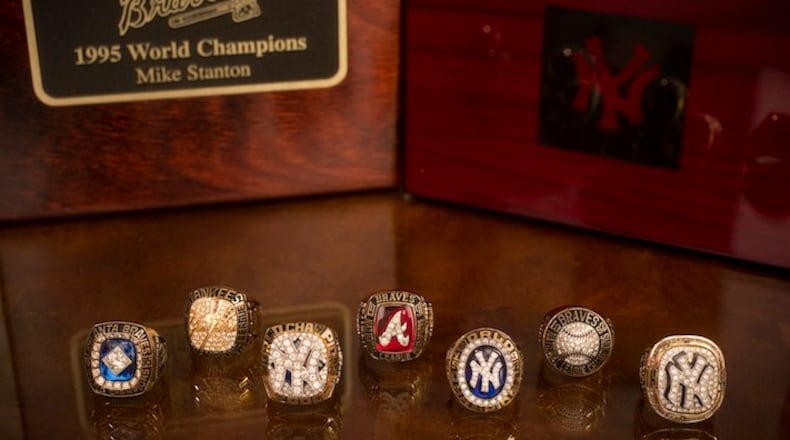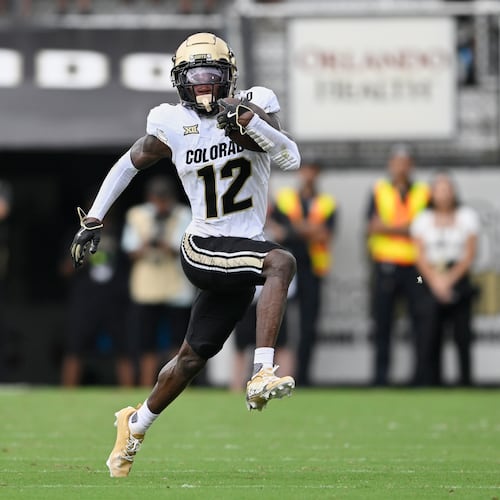The day after opening day in April, the Kansas City Royals invited hundreds of their employees to a luncheon in the Diamond Club, the lounge area behind home plate at Kauffman Stadium. The guests included security guards, electricians and janitors; part-time employees and full-time employees; anyone who worked with the team in the 2014 season.
One by one, Royals upper management called the employees to the front of the room, shook their hand and presented them with a championship ring — a similar ring to the one the players had received the day before, customized with their surname on the side. It was delivered in the same glossy wooden box that, when opened, lit up and made the ring sparkle.
The Royals had lost to the San Francisco Giants in the 2014 World Series in seven games. But per baseball tradition, the Royals made championship rings anyway — albeit a more modest version — for winning the American League pennant. For a franchise that had not made the playoffs since 1985, they decided that the season was still worth commemorating.
The New York Mets, who waited 15 years between their NL pennant in 2000 and this season’s, are now in a similar situation. They said Monday that they expected to follow baseball custom and make National League championship rings, even though they lost the 2015 Series to the Royals in five games.
Royals officials said their decision was not difficult, after the team’s rousing run to the World Series that captured the region’s attention. Not long after the 2014 season ended, Kevin Uhlich, the Royals’ senior vice president for business operations, approached two ring companies, Jostens and Herff Jones, and gave them the same set of directives for a prospective AL pennant ring. For about three weeks, each company sent the Royals a series of sketches. Uhlich conferred with general manager Dayton Moore and Dan Glass, the team president and son of the owner, David Glass. They discussed every detail, down to the size of the ring.
Glass wanted to spare no expense. But Uhlich and Moore persuaded him to tone down the ring and keep it to a reasonable size, something fitting of a pennant, not a World Series. They had both companies make sample rings, and they chose Jostens’ design.
“We think it’s a beautiful ring,” Uhlich said. “But we did consciously make sure that we left a little distance, in the event we were lucky enough to win a World Series. How would we take it to another level?”
This is not a common problem across professional sports. NHL teams that lose out on hoisting the Stanley Cup do not typically hand out rings. In the NBA, where some fans believe that rings define a player’s legacy, teams do not give out rings when they lose in the finals.
The NFL pays for 150 rings for the Super Bowl runner-up, but, by rule, the cost can at most be half of what the league pays for the winner’s rings. By definition, then, the NFL’s conference championship rings are more modest by comparison. The Buffalo Bills have four such AFC championship rings from the 1990s.
Baseball remains a sport in which the team that loses the championship often gives itself rings. Major League Baseball covers up to $1,500 of the cost of each ring for members of the World Series-winning team — for the players, coaches, manager and general manager. The team must cover any costs above that, and the price is routinely significantly higher.
But the team that loses the Series must buy all of its own league championship rings.
It is unclear when that practice started. Winning the pennant has always been a revered accomplishment in baseball, dating to the 1800s, before the inception of the American League. John Thorn, the official league historian, said the tradition of pennant-winning rings was cemented in 1995, when baseball added the division series to the postseason and made reaching the World Series that much more difficult of an accomplishment and something to celebrate.
The owners usually decide how much to spend on a league championship ring, how elaborate to make it and who receives one. David Glass, the Royals owner, had three versions of their rings made, each with slight differences in the quality. In all, he gave out more than 600 rings and had two ceremonies: one for the players on opening day and the luncheon for other employees the next day. Uhlich said the total cost was in “seven figures.”
“It’s totally up to the owners,” Uhlich said, “how far they would like to go.”
Among those in attendance for the employees’ ceremony was Trevor Vance, the Royals’ head groundskeeper. Born and raised in Kansas City, Missouri, he joined the organization as a part-time employee in 1985, fresh out of high school. He has worked for the Royals ever since, tending to the field during sweltering summers, rolling tarp during rain delays, working his way up in the organization.
“It was absolutely stunning,” Vance said of the ring. “It just took your breath away. I had been waiting 30 years to finally get one of those rings.”
Vance did not seem to mind that it was not, in fact, a World Series ring. He put his ring in a safe-deposit box and wore it only about a half-dozen times this year, for special occasions. He would wear it more, he said, but it became a distraction, with people gawking at it, when he took it to events or family functions.
How a team regards a league championship ring depends largely on their expectations, history and pedigree. Bobby Valentine, the former Mets manager, held his ring from the 2000 season in high regard. He kept it displayed in a game room, as a reminder of the only time he ever led a team to the World Series in his 16 years as a major league manager.
When Valentine took a job with the Boston Red Sox a few years ago, though, he rented out his house in Connecticut and, he said, the ring disappeared in the process of moving his things.
“I never got to wear it,” Valentine said chuckling, though he is not one to wear jewelry. “I keep trying to find it on eBay somewhere. Figure it’d be a nice thing for my kid to have.”
The New York Yankees, who have won 27 World Series in their storied history, have 26 championship rings and one championship pocket watch, from their first title in 1923. When they lose a World Series, they make a clear distinction between the two rings.
The Series rings feature their classic interlocking “NY” logo, and the league championship rings use their top hat logo. According to general manager Brian Cashman, George Steinbrenner, the Yankees’ longtime owner, preferred the former design. Steinbrenner often wore his championship rings around the office, but never a ring with a top hat.
“He referred to it as the ‘losers’ ring,’” Cashman said.
After the Yankees won four World Series in five years and then lost the 2001 Series to the Arizona Diamondbacks on a blown save in Game 7 by Mariano Rivera, they still made rings commemorating the season, even if they did not seem overjoyed about it.
“The ceremony the next year could not have been more subdued or shorter,” said Mike Stanton, a pitcher on that team. “I’m not even sure how much they advertised it, as far as the media or fans were concerned. It seemed like it was an afterthought. ‘We have to give them rings.’ They basically threw them at us. It took like a grand total of five minutes.”
Over his 19-year major league career, Stanton collected eight rings in stops with the Atlanta Braves and the Yankees — three league championship rings, four World Series rings and a special ring Roger Clemens had made for winning the 1999 Series, his first Series win.
Asked which ring was his favorite, Stanton named the 1991 Braves league championship ring and the 2000 Yankees Series ring, because of how well he pitched in those series. The 1991 ring, though, held a special place in his heart because he won that as a 24-year-old rookie.
“You never forget that first one,” Stanton said, a notion that should resonate with the Mets’ young pitchers. “Even though we lost, those were life experiences that will never be duplicated. Even if you go on to win the World Series, you will never forget the first one.”
About the Author
Keep Reading
The Latest
Featured

